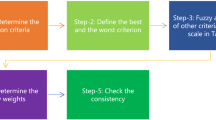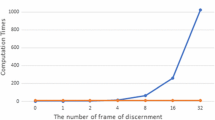Abstract
Failure mode and effect analysis (FMEA) is a prospective risk assessment tool used to identify, assess and eliminate potential failure modes in various industries to improve security and reliability. However, the conventional risk priority number (RPN) method has been widely criticized for the deficiencies in risk factor weights, calculation of RPN, evaluation of failure modes, etc. In this paper, we present a novel approach for FMEA based on interval-valued intuitionistic fuzzy sets (IVIFSs) and MULTIMOORA method to handle the uncertainty and vagueness from FMEA team members’ subjective assessments and to get a more accurate ranking of failure modes identified in FMEA. In this proposed model, interval-valued intuitionistic fuzzy (IVIF) continuous weighted entropy is applied for risk factor weighting and the IVIF-MULTIMOORA method is used to determine the risk priority order of failure modes. Finally, an illustrative case is provided to demonstrate the effectiveness and practicality of the proposed FMEA and a comparison analysis with other relevant methods is conducted to show its merits.


Similar content being viewed by others
Explore related subjects
Discover the latest articles, news and stories from top researchers in related subjects.References
Atanassov K, Gargov G (1989) Interval valued intuitionistic fuzzy sets. Fuzzy Sets Syst 31(3):343–349
Atanassov KT (1986) Intuitionistic fuzzy sets. Fuzzy Sets Syst 20(1):87–96
Balezentiene L, Streimikiene D, Balezentis T (2013) Fuzzy decision support methodology for sustainable energy crop selection. Renew Sustain Energy Rev 17:83–93
Baležentis A, Baležentis T, Brauers WK (2012) Personnel selection based on computing with words and fuzzy MULTIMOORA. Expert Syst Appl 39(9):7961–7967
Baležentis T, Zeng S (2013) Group multi-criteria decision making based upon interval-valued fuzzy numbers: an extension of the MULTIMOORA method. Expert Syst Appl 40(2):543–550
Baležentis T, Baležentis A (2014) A survey on development and applications of the multi-criteria decision making method MULTIMOORA. J Multi Criteria Decis Anal 21(3–4):209–222
Baležentis T, Zeng S, Baležentis A (2014) MULTIMOORA-IFN: a MCDM method based on intuitionistic fuzzy number for performance management. Econ Comput Econ Cybern Stud Res 48(4):85–102
Bowles JB, Peláez CE (1995) Fuzzy logic prioritization of failures in a system failure mode, effects and criticality analysis. Reliab Eng Syst Saf 50(2):203–213
Brauers WKM, Zavadskas EK (2006) The MOORA method and its application to privatization in a transition economy. Control Cybern 35(2):445–469
Brauers WKM, Zavadskas EK (2010) Project management by MULTIMOORA as an instrument for transition economies. Technol Econ Dev Econ 16(1):5–24
Brauers WKM, Zavadskas EK (2011) MULTIMOORA optimization used to decide on a bank loan to buy property. Technol Econ Dev Econ 17(1):174–188
Brauers WKM, Kildienė S, Zavadskas EK, Kaklauskas A (2013) The construction sector in twenty European countries during the recession 2008–2009—country ranking by MULTIMOORA. Int J Strategic Prop Manag 17(1):58–78
Chang D, Chung J, Sun K, Yang F (2012) A novel approach for evaluating the risk of health care failure modes. J Med Syst 36(6):3967–3974
Debasis Das A, Goutam Kumar B, Dipankar B, Souren M (2014) Multi criteria FMECA for coal-fired thermal power plants using COPRAS-G. Int J Qual Reliab Manag 31(5):601–614
Du Y, Lu X, Su X, Hu Y, Deng Y (2016) New failure mode and effects analysis: An evidential downscaling method. Qual Reliab Eng Int 32:737–746
Franceschini F, Galetto M (2001) A new approach for evaluation of risk priorities of failure modes in FMEA. Int J Prod Res 39(13):2991–3002
Garg H (2016) A new generalized improved score function of interval-valued intuitionistic fuzzy sets and applications in expert systems. Appl Soft Comput 38:988–999
Geum Y, Cho Y, Park Y (2011) A systematic approach for diagnosing service failure: Service-specific FMEA and grey relational analysis approach. Math Comput Model 54(11–12):3126–3142
Hajiagha SHR, Hashemi SS, Zavadskas EK (2013) A complex proportional assessment method for group decision making in an interval-valued intuitionistic fuzzy environment. Technol Econ Dev Econ 19(1):22–37
Helvacioglu S, Ozen E (2014) Fuzzy based failure modes and effect analysis for yacht system design. Ocean Eng 79:131–141
Jin F, Pei L, Chen H, Zhou L (2014) Interval-valued intuitionistic fuzzy continuous weighted entropy and its application to multi-criteria fuzzy group decision making. Knowl Based Syst 59:132–141
Kahraman C, Kaya İ, Şenvar Ö (2012) Healthcare failure mode and effects analysis under fuzziness. Human Ecol Risk Assess 19(2):538–552
Lazauskas M, Kutut V, Zavadskas EK (2015a) Multicriteria assessment of unfinishaed construction projects. Gradevinar 67(4):319–328
Lazauskas M, Zavadskas EK, Šaparauskas J (2015b) Ranking of priorities among the baltic capital cities for the development of sustainable construction? Econ Manag Ekonomie a Manag 18(2):15–24
Liu B, Shen Y, Zhang W, Chen X, Wang X (2015d) An interval-valued intuitionistic fuzzy principal component analysis model-based method for complex multi-attribute large-group decision-making. Eur J Oper Res 245(1):209–225
Liu HC, Liu L, Liu N, Mao LX (2012) Risk evaluation in failure mode and effects analysis with extended VIKOR method under fuzzy environment. Expert Syst Appl 39(17):12926–12934
Liu HC, Liu L, Liu N (2013a) Risk evaluation approaches in failure mode and effects analysis: A literature review. Expert Syst Appl 40(2):828–838
Liu HC, Liu L, Lin QL (2013b) Fuzzy failure mode and effects analysis using fuzzy evidential reasoning and belief rule-based methodology. IEEE Trans Reliab 62(1):23–36
Liu HC, Fan XJ, Li P, Chen YZ (2014a) Evaluating the risk of failure modes with extended MULTIMOORA method under fuzzy environment. Eng Appl Artif Intell 34:168–177
Liu HC, Li P, You JX, Chen YZ (2014b) A novel approach for FMEA: combination of interval 2-tuple linguistic variables and gray relational analysis. Qual Reliab Eng Int 31(5):761–772
Liu HC, You JX, Lu C, Shan MM (2014c) Application of interval 2-tuple linguistic MULTIMOORA method for health-care waste treatment technology evaluation and selection. Waste Manage 34(11):2355–2364
Liu HC, You JX, Shan MM, Shao LN (2015a) Failure mode and effects analysis using intuitionistic fuzzy hybrid TOPSIS approach. Soft Comput 19(4):1085–1098
Liu HC, You JX, Lin QL, Li H (2015b) Risk assessment in system FMEA combining fuzzy weighted average with fuzzy decision making trial and evaluation laboratory. Int J Comput Integr Manuf 28(7):701–714
Liu HC, You JX, Ding XF, Su Q (2015c) Improving risk evaluation in FMEA with a hybrid multiple criteria decision making method. Int J Qual Reliab Manag 32(7):763–782
Liu HC, You JX, Lu C, Chen YZ (2015e) Evaluating health-care waste treatment technologies using a hybrid multi-criteria decision making model. Renew Sustain Energy Rev 41:932–942
Long S, Geng S (2015) Decision framework of photovoltaic module selection under interval-valued intuitionistic fuzzy environment. Energy Convers Manag 106:1242–1250
Mandal S, Maiti J (2014) Risk analysis using FMEA: Fuzzy similarity value and possibility theory based approach. Expert Syst Appl 41(7):3527–3537
Mardani A, Jusoh A, Nor KMD, Khalifah Z, Zakwan N, Valipour A (2015a) Multiple criteria decision-making techniques and their applications—a review of the literat ure from 2000 to 2014. Econ Res Ekonomska Istraživanja 28(1):516–571
Mardani A, Jusoh A, Zavadskas EK (2015b) Fuzzy multiple criteria decision-making techniques and applications—two decades review from 1994 to 2014. Expert Syst Appl 42(8):4126–4148
Masri H (2014) Quantitative economics as a scientific approach to the solution of problems of a complex nature—in honor of Professor Willem Karel M. Brauers on the occasion of his 90th birthday. Technol Econ Dev Econ 20(3):590–600
Netto TA, Honorato HJ, Qassim RY (2013) Prioritization of failure risk in subsea flexible pipes via data envelopment analysis. Marine Struct 34:105–116
Onar SC, Oztaysi B, Otay İ, Kahraman C (2015) Multi-expert wind energy technology selection using interval-valued intuitionistic fuzzy sets. Energy 90:274–285
Safari H, Faraji Z, Majidian S (2014) Identifying and evaluating enterprise architecture risks using FMEA and fuzzy VIKOR. J Intell Manuf. doi:10.1007/s10845-014-0880-0
Şahin R (2015) Fuzzy multicriteria decision making method based on the improved accuracy function for interval-valued intuitionistic fuzzy sets. Soft Comput. doi:10.1007/s00500-015-1657-x
Salmeron JL, Gutierrez E (2012) Fuzzy grey cognitive maps in reliability engineering. Appl Soft Comput 12(12):3818–3824
Selim H, Yunusoglu MG, Yilmaz Balaman Ş (2015) A dynamic maintenance planning framework based on fuzzy TOPSIS and FMEA: application in an international food company. Quality and Reliability Engineering International. doi:10.1002/qre.1791
Seyed-Hosseini SM, Safaei N, Asgharpour MJ (2006) Reprioritization of failures in a system failure mode and effects analysis by decision making trial and evaluation laboratory technique. Reliab Eng Syst Saf 91(8):872–881
Silva MM, de Gusmão APH, Poleto T, Silva LCe, Costa APCS, (2014) A multidimensional approach to information security risk management using FMEA and fuzzy theory. Int J Inf Manag 34(6):733–740
Stamatis DH (2003) Failure mode and effect analysis: FMEA from theory to execution. ASQ Quality Press, USA
Stankevičienė J, Čepulytė J (2014) Sustainable value creation: coherence of corporate social responsibility and performance of socially responsible investment funds. Econ Res Ekonomska Istraživanja 27(1):882–898
Streimikiene D, Balezentis T, Krisciukaitienė I, Balezentis A (2012) Prioritizing sustainable electricity production technologies: MCDM approach. Renew Sustain Energy Rev 16(5):3302–3311
Tay K, Jong C, Lim C (2015) A clustering-based failure mode and effect analysis model and its application to the edible bird nest industry. Neural Comput Appl 26(3):551–560
Vahdani B, Salimi M, Charkhchian M (2014) A new FMEA method by integrating fuzzy belief structure and TOPSIS to improve risk evaluation process. Int J Adv Manuf Technol 77(1–4):357–368
Vinodh S, Aravindraj S, Ravi Sathya N, Yogeshwaran N (2012) Fuzzy assessment of FMEA for rotary switches: a case study. TQM J 24(5):461–475
Wan SP, Dong JY (2015) Interval-valued intuitionistic fuzzy mathematical programming method for hybrid multi-criteria group decision making with interval-valued intuitionistic fuzzy truth degrees. Inf Fusion 26:49–65
Wang YM, Chin KS, Poon GKK, Yang JB (2009) Risk evaluation in failure mode and effects analysis using fuzzy weighted geometric mean. Expert Syst Appl 36(2):1195–1207
Wu J, Cao Q, Li H (2015) An approach for MADM problems with interval-valued intuitionistic fuzzy sets based on nonlinear functions. Technol Econ Dev Econ 21(1):28–47
Xu Z (2007) Methods for aggregating interval-valued intuitionistic fuzzy information and their application to decision making. Control Decis 22(2):215
Xue YX, You JX, Lai XD, Liu HC (2016) An interval-valued intuitionistic fuzzy MABAC approach for material selection with incomplete weight information. Appl Soft Comput 38:703–713
Yager RR (1988) On ordered weighted averaging aggregation operators in multicriteria decisionmaking. IEEE Trans Syst Man Cybern 18(1):183–190
Yager RR (2004) OWA aggregation over a continuous interval argument with applications to decision making. IEEE Trans Syst Man Cybern Part B 34(5):1952–1963
Ye F (2010) An extended TOPSIS method with interval-valued intuitionistic fuzzy numbers for virtual enterprise partner selection. Expert Syst Appl 37(10):7050–7055
Zadeh LA (1965) Fuzzy sets. Inf Control 8(3):338–353
Zavadskas EK, Turskis Z, Volvačiovas R, Kildiene S (2013) Multi-criteria assessment model of technologies. Stud Inf Control 22(4):248–258
Zavadskas EK, Turskis Z, Kildienė S (2014a) State of art surveys of overviews on MCDM/MADM methods. Technol Econ Dev Econ 20(1):165–179
Zavadskas EK, Antucheviciene J, Hajiagha SHR, Hashemi SS (2014b) Extension of weighted aggregated sum product assessment with interval-valued intuitionistic fuzzy numbers (WASPAS-IVIF). Appl Soft Comput 24:1013–1021
Zavadskas EK, Antucheviciene J, Hajiagha SHR, Hashemi SS (2015) The interval-valued intuitionistic fuzzy MULTIMOORA method for group decision making in engineering. Math Probl Eng:1–13 (article ID 560690). doi:10.1155/2015/560690
Acknowledgments
The authors are very grateful to the editor and the anonymous reviewers for their constructive comments and suggestions that have led to an improved version of this paper. This work was supported by the National Natural Science Foundation of China (No. 71402090), the NSFC key program (No. 71432007) and the Project funded by China Postdoctoral Science Foundation (No. 2015T80456), the Program for Young of Special Appointment (Eastern Scholar) at Shanghai Institutions of Higher Learning (No. QD2015019), and the Chen Guang project supported by Shanghai Municipal Education Commission and Shanghai Education Development Foundation.
Author information
Authors and Affiliations
Corresponding author
Ethics declarations
Conflict of interest
The authors declare that they have no conflict of interest.
Additional information
Communicated by V. Loia.
Rights and permissions
About this article
Cite this article
Zhao, H., You, JX. & Liu, HC. Failure mode and effect analysis using MULTIMOORA method with continuous weighted entropy under interval-valued intuitionistic fuzzy environment. Soft Comput 21, 5355–5367 (2017). https://doi.org/10.1007/s00500-016-2118-x
Published:
Issue Date:
DOI: https://doi.org/10.1007/s00500-016-2118-x




